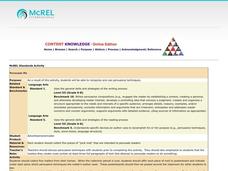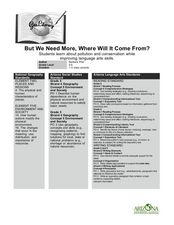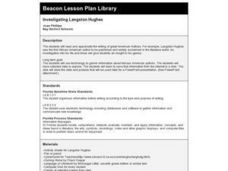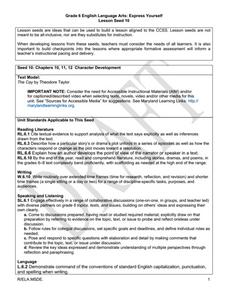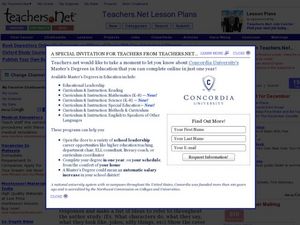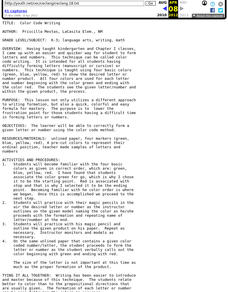Curated OER
Persuade Me
Students develop their writing skills. In this writing strategies instructional activity, students examine persuasive writing techniques on order to write persuasive mailers.
Curated OER
Writing a Book Review - Non-Fiction
Fifth graders write a book review for a nonfiction book. In this response to literature activity, 5th graders read a nonfiction book and write a review that gets others interested in reading the book without giving too much away. The...
Curated OER
Organizing One’s Thoughts
High schoolers take a closer look at the organization of written pieces. In this writing skills lesson, students examine transitions, repetition, parallelism, and other organizational patterns in writing.
Curated OER
Looking Inside a Textbook
Students practice newly acquired knowledge by working in pairs or is small group to answer questions in a practice sheet. They become familiar with the terminology used to identify textbooks. Pupils give the definition of: Textbook,...
Curated OER
But We Need More, Where Will It Come From?
Students write a persuasive letter and create a poster about pollution and conservation. In this pollution and conservation lesson plan, students learn how humans are the number 1 cause of pollution.
Curated OER
Comic Book Project
Young scholars write a fictional story into a comic book format. In this creative writing lesson, students analyze example comics and discuss the format. Young scholars create a comic book using imaginary characters that find a solution...
Curated OER
Summarizing
Fifth graders write summaries. In this summarizing lesson students decide which events of a chapter in a book are important to summarizing. Students also create a title for the chapter based upon the contents of the chapter. Students...
Curated OER
The Job Application
Students complete job applications. In this written communication instructional activity, students discuss the purpose of job applications and then complete job applications in their field.
Curated OER
Investigating Langston Hughes
Third graders read and appreciate the writing of great American Authors. use technology to garner information about famous American authors. They have selected sites to explore. The information they save be used for a future Powerpoint.
Curated OER
Ornithology and Real World Science
Double click that mouse because you just found an amazing instructional activity! This cross-curricular Ornithology instructional activity incorporates literature, writing, reading informational text, data collection, scientific inquiry,...
Los Angeles Unified School District
Capitalism and Socialism
Capitalism, socialism, communism ... these may seem like a whole bunch of isms to your scholars. High schoolers won't confuse them after completing an informative resource. Your class masters how to use primary sources to...
Southern Nevada Regional Professional Development Program
Common Core Reading Standards: Understanding Argument
What does your class know about logical fallacies? They can find out quite a bit and practice identifying logical fallacies if you follow the steps and use the resources provided here! After reviewing ethos, pathos, and logos, ask small...
Curated OER
Modernism in Poetry, Painting, and Music
Are you teaching Modernism to your class? Connect different areas of artistic expression in the Modernist Era. Learners read T.S. Eliot, view art by Pablo Picasso, and listen to a Modernist musical composition. This final assignment is...
Curated OER
Express Yourself Lesson Seed 10: Character Development
Make a study of Timothy and his development as a character over the course of the first half or so of The Cay. This idea focuses in particular on chapters 10 through 12. Learners start out by working on double-entry journals created in...
Curated OER
Robert Munsch: Author Study
Young scholars study Robert Munsch's style of writing. In this literature lesson, students read many of Robert Munsch's books, write a list of the characteristics found in his books, and write or orally tell a...
Curated OER
Writing for Different Purposes and Audiences
Third graders explore how to write for different purposes and for a specific audience or person. They read, Where the Wild Things Are by Maurice Sendak. Students create a class book after reading the story. They each create their own...
Curated OER
A Penny For Your Thoughts: Cross-Curricular Journal Writing
Students are introduced to the importance of journal writing. After creating their own journal, they write their thoughts and feelings about different subjects. If they choose to they can share their writings with the class to end the...
Curated OER
Analyzing Speaker, Language, and Tone in the Writings of Benjamin Franklin
Students analyze writings by Benjamin Franklin. In this Benjamin Franklin lesson plan, students discover the pseudonyms under which Franklin used to write. Students compare and contrast 2 selections by Franklin.
Curated OER
Integrated Vocabulary, Creative Writing and Listening Exercise
Students learn vocabulary words. In this reading and vocabulary lesson, students write a word, listen for it in a story and write down what they think it means.
Curated OER
Autobiography
Sixth graders read and write autobiographical sketches, determine the author's purpose in writing, and type paragraphs using WP utilities.
Curated OER
Response to Literature: Feelings About the Book
Students read chapter 17 in the story NUMBER THE STARS and think about the author's purpose for writing the book. They are encouraged to share with the class their personal reactions to the story.
Curated OER
Using Keywords
Third graders identify how to use keywords in resources. In this using keywords lesson, 3rd graders practice using keywords from a table of contents. Students also formulate questions for peers using keywords from orgainzers.
Curated OER
Author, Author!
Third graders, in groups, select and research a favorite studenT author or illustrator. They answer questions about the author, conduct research and prepare a PowerPoint presentation with their findings.
Curated OER
Color Code Writing
Students form letters and numbers using a technique called color code writing.
